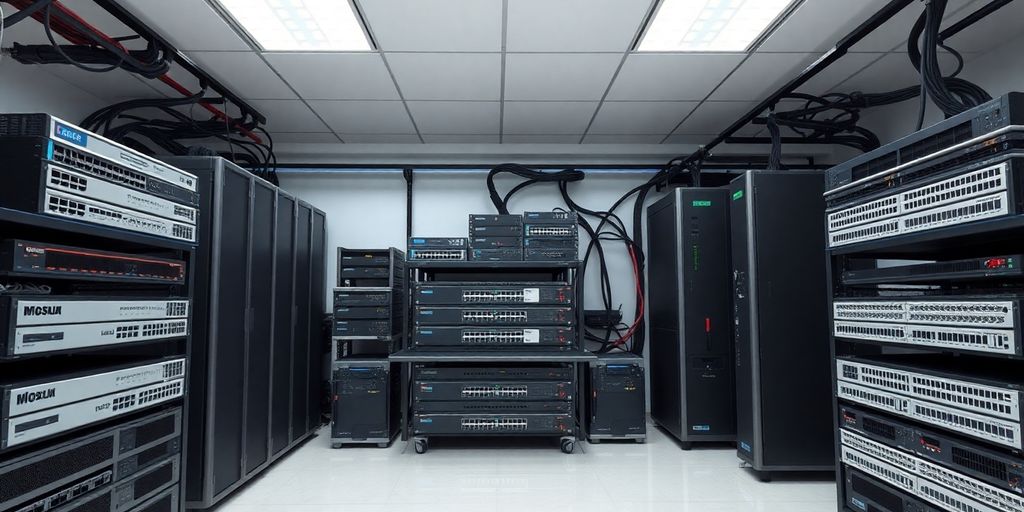Starting a radio show in 2025? It’s not just about having a voice; it’s about having the right gear. From transmitters to mixing consoles, the equipment you choose can make or break your broadcast. Let’s walk through the must-haves for any budding radio host.
Key Takeaways
- Transmitters are the backbone of any radio station, sending your voice to the world.
- Mixing consoles help balance all the audio elements, ensuring your show sounds great.
- Choosing the right microphone is key to capturing clear and quality sound.
- Soundproofing your studio can drastically improve audio quality by eliminating background noise.
- Affordable gear options are available for beginners, making it easier to start broadcasting.
Understanding the Basics of Radio Equipment
The Role of Transmitters in Broadcasting
Transmitters are the backbone of any radio station. They’re the magic behind converting audio signals into radio waves that travel through the air. Think of them as the heart of your broadcasting setup. Without a transmitter, your voice would never reach your audience. Transmitter types vary, from full-power for large stations to more compact versions for smaller setups. Choosing the right one depends on your station’s needs and reach.
Importance of Mixing Consoles
Mixing consoles are like the control center of your radio station. They allow you to blend different audio sources, adjust sound levels, and ensure the final output is just right. If you’ve ever seen a DJ at work, you’ve seen a mixing console in action. It’s all about balance and control. Whether you’re dealing with music, interviews, or live calls, a good mixing console ensures everything sounds perfect.
Choosing the Right Microphone
Microphones are where your voice first enters the radio world. Picking the right one is crucial for clarity and quality. You’ll find various types, like dynamic, condenser, and ribbon microphones. Each has its own strengths. Dynamic mics are sturdy and versatile, great for general use. Condenser mics capture more detail, ideal for studio settings. Ribbon mics offer a unique sound, perfect for certain voice types. The key is to match the mic to your voice and broadcasting style.
Setting Up Your Radio Studio
Essential Studio Components
Starting a radio studio? Well, it’s not just about having a microphone and a mixer. You need a solid setup to ensure everything runs smoothly. Here are some must-have components:
- Transmitter: The heart of your operation. It takes your audio signal and sends it out as radio waves.
- Mixing Console: Think of it as your command center. It lets you blend different audio sources, control levels, and tweak the sound.
- Speakers: You need good speakers to monitor what you’re broadcasting. Studio-grade ones are best for accurate sound.
- Widescreen Monitor: This is crucial for keeping an eye on audio levels and other important data during broadcasts.
Soundproofing Techniques
Nothing kills a broadcast faster than unwanted noise. Soundproofing is your best friend here. Try these techniques:
- Acoustic Panels: These help absorb sound and reduce echo.
- Seal Gaps: Make sure doors and windows are sealed tight to keep outside noise from creeping in.
- Carpets and Curtains: Soft furnishings can help dampen sound and improve acoustics.
Optimizing Studio Layout
A well-organized studio isn’t just about aesthetics. It can actually make your work easier. Consider these tips:
- Ergonomic Setup: Make sure your desk and chair are comfortable for long hours.
- Cable Management: Keep cables neat and out of the way to avoid accidents or interference.
- Equipment Placement: Position your gear within easy reach to streamline your workflow.
Setting up a radio studio is a blend of art and science. It’s about creating a space where you can focus on delivering great content without distractions. With the right setup, you’ll be well on your way to broadcasting success.
Advanced Radio Equipment for Enhanced Broadcasts

Utilizing Audio Processors
Audio processors are like the unsung heroes of radio broadcasting. They help tweak and refine the sound, making sure that everything from music to talk shows sounds just right. By adjusting levels and frequencies, they ensure that the broadcast is smooth and clear. Think of them as the final touch that makes your station sound professional. If you’re serious about quality, investing in a good audio processor is a must.
Incorporating Smart Speakers
Smart speakers are changing the game for radio stations. They allow listeners to tune in using voice commands, making it super convenient for them. With devices like Amazon Echo and Google Home, your station can reach a wider audience. It’s not just about playing music; smart speakers can also provide interactive experiences. Consider Super Hi-Fi’s "High Margin Radio" model, which uses AI to enhance broadcasts, making them more engaging and personalized.
Leveraging Widescreen Monitors
Widescreen monitors aren’t just for better visuals—they’re crucial for radio studios. They help in managing multiple tasks simultaneously, from monitoring audio levels to managing playlists. With a widescreen, you can have all your necessary software open and visible, reducing the need to switch between screens. This setup not only boosts efficiency but also helps in maintaining a smooth broadcast flow. So, if you’re setting up a studio, don’t skimp on a good monitor.
The Importance of Quality Headphones in Broadcasting
Preventing Sound Leakage
One of the key roles of quality headphones in broadcasting is to prevent sound leakage. When sound escapes from your headphones, it can be picked up by microphones, causing feedback and other unwanted noise issues. This is why closed-back headphones are often recommended for broadcasters. They create a seal around your ears, keeping the sound contained. This ensures that what you hear is exactly what’s being recorded, without any interference from external noise.
Ensuring Clear Communication
In a radio studio, clear communication is crucial. Headphones allow broadcasters to hear themselves and others clearly, maintaining smooth and uninterrupted conversations. This is especially important during interviews or live discussions where timing and clarity can make or break the show. With the right headphones, you can catch every nuance of a conversation, ensuring that listeners get the best possible audio experience.
Selecting Wireless Options for Mobility
For broadcasters who need to move around the studio, wireless headphones provide the freedom to do so without being tethered to a desk. These headphones offer the same audio quality as their wired counterparts, but with the added benefit of mobility. Whether you’re adjusting equipment or engaging with guests, wireless headphones allow you to stay connected to the audio feed without any hassle.
Investing in quality headphones is not just about sound quality; it’s about creating a seamless broadcasting experience. With the right pair, you can focus on delivering great content without worrying about technical hiccups.
When choosing headphones, consider factors such as comfort, sound quality, and durability. A good pair of headphones can last for years, making them a worthwhile investment for any broadcaster. For more on essential podcast equipment, including headphones, check out our guide.
Exploring Online Streaming Options
Benefits of Web Radio
Web radio is a fantastic way to kickstart your broadcasting journey without the hefty costs of traditional radio. It’s super accessible, both for you and your listeners. With just a computer and an internet connection, you’re ready to go. Plus, your audience can tune in from anywhere—be it on their laptop, smartphone, or smart speaker. It’s like having a global stage right at your fingertips.
- Cost-effective: No need for expensive transmitting equipment.
- Wide reach: Anyone with internet access can listen.
- Flexible: Broadcast anytime, anywhere.
Licensing Requirements for Internet Radio
Even though online streaming is more straightforward than traditional broadcasting, you still need to consider licensing, especially if you’re playing music. Securing the right music licenses is crucial to avoid legal issues. This might seem like a hassle, but it’s a necessary step to ensure your station runs smoothly.
Here’s a quick checklist for getting started:
- Research the types of licenses needed for your content.
- Contact licensing bodies to acquire the necessary permits.
- Keep track of your music library to ensure compliance.
Integrating Mobile Apps and Smart Speakers
In today’s world, it’s all about convenience. Integrating your station with mobile apps and smart speakers can significantly boost your listener base. Imagine your audience asking their smart speaker to tune into your station while they’re cooking dinner or driving to work. That’s the kind of accessibility you want.
- Mobile Apps: Consider developing an app for your station. It makes it easier for listeners to access your content on the go.
- Smart Speakers: Ensure your station is compatible with devices like Alexa and Google Home.
Broadcasting online opens up a world of opportunities. With the right approach, you can build a thriving community around your station. Embrace the digital age and let your voice be heard far and wide.
For those interested in exploring unique streaming platforms, check out these 45 lesser-known services that offer diverse content beyond the mainstream options. This could be a great opportunity to find your niche and attract a dedicated audience.
Budget-Friendly Radio Equipment for Beginners

Starting out in radio broadcasting doesn’t have to break the bank. There are plenty of affordable options that deliver great quality without the hefty price tag.
Affordable Microphone Options
When you’re just getting started, a good microphone is essential. You don’t need to spend hundreds of dollars to get decent sound quality. Consider dynamic microphones, which are generally more affordable and robust. A solid choice is the Shure SM58, known for its durability and clear sound. It’s a favorite among beginners and pros alike.
Cost-Effective Mixing Consoles
Mixing consoles can be pricey, but there are budget-friendly options that do the job well. Look for compact models that offer essential features like basic EQ and multiple input channels. The Behringer Xenyx series is often recommended for beginners due to its affordability and functionality.
Budget Studio Headphones
Quality headphones are crucial for monitoring your broadcasts. You want something that offers good sound isolation and comfort for long periods. The Audio-Technica ATH-M20x is a great entry-level option that provides excellent sound quality without costing a fortune.
Starting your radio journey on a budget is totally doable. It’s all about finding the right gear that balances cost with quality. With the right tools, you can create professional-sounding broadcasts without spending a ton.
Consider also the Studebaker SB2000 as a budget-friendly tabletop radio for those new to radio listening. It’s a great way to get acquainted with the medium without a big financial commitment.
Innovative Tools for Modern Broadcasters
The Rise of Podcast Studio Kits
Podcast studio kits are becoming a must-have for broadcasters these days. They come with everything you need to get started, like microphones, mixers, and headphones. These kits are perfect for both newbies and seasoned pros. With a podcast studio kit, you can easily set up a professional-grade studio at home or in a small office. The convenience and affordability of these kits are revolutionizing the way people approach broadcasting.
Adapting to New Broadcasting Technologies
The broadcasting world is constantly changing, and staying up-to-date with the latest tech is key. From streaming platforms to interactive streaming features, there’s always something new to learn. Broadcasters are now using advanced software for editing and mixing, making it easier to produce high-quality content. Keeping an eye on these advancements helps broadcasters remain competitive and relevant.
Future Trends in Radio Equipment
Looking ahead, the future of radio equipment is all about integration and efficiency. Expect to see more multifunctional devices that combine several pieces of equipment into one. This not only saves space but also makes the broadcasting process smoother. Wireless technology is also expected to play a bigger role, offering more flexibility and mobility for broadcasters.
As technology evolves, broadcasters must be adaptable and willing to embrace new tools and methods. The future is bright for those who are ready to innovate and experiment with the latest broadcasting equipment.
Conclusion
Starting out in radio broadcasting can feel like a big leap, but with the right gear, it’s totally doable. Whether you’re setting up in a school or your own home, having the right equipment makes all the difference. From microphones to mixing consoles, each piece plays a part in creating a smooth broadcast. And let’s not forget the importance of headphones and monitors for keeping everything sounding just right. As technology keeps evolving, the tools for broadcasting are getting more accessible and easier to use. So, if you’re passionate about sharing your voice with the world, now’s a great time to dive in and start your broadcasting journey. Who knows? You might just find your new favorite hobby or even a career path. Happy broadcasting!
Frequently Asked Questions
What is a radio transmitter?
A radio transmitter sends out radio waves carrying sound or music to radios so listeners can hear broadcasts from far away.
Why are mixing consoles important in a radio studio?
Mixing consoles help control and mix different audio signals, making sure everything sounds just right during a broadcast.
How do I choose the right microphone for broadcasting?
Pick a microphone that matches your voice type and needs. Dynamic mics are good for loud environments, while condenser mics capture more detail.
What are the benefits of using widescreen monitors in a radio studio?
Widescreen monitors help spot and fix unwanted background noise, boosting confidence by providing real-time feedback during broadcasts.
Why are quality headphones essential for broadcasters?
Good headphones stop sound from leaking and help everyone hear clearly, which is important for smooth conversations and clear communication.
What should I consider when exploring online radio streaming options?
Think about the benefits like reaching more listeners, the need for music licenses, and how to integrate with mobile apps and smart speakers.



